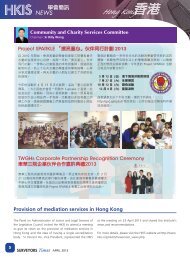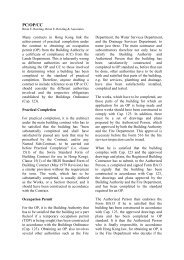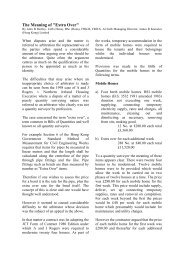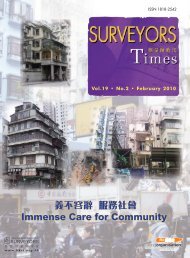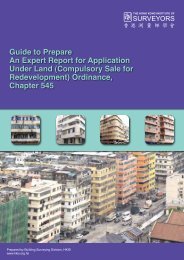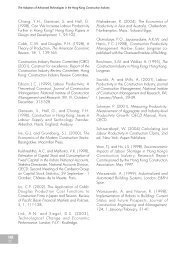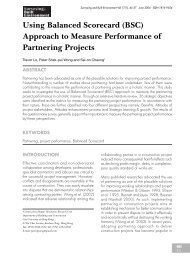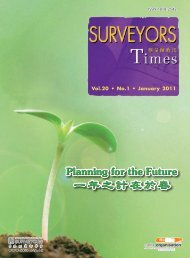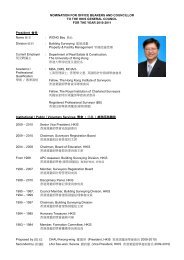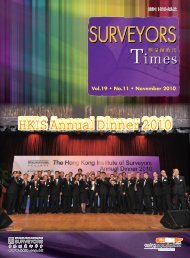Surveying & Built Environment Vol. 22 Issue 1 (December 2012)
Surveying & Built Environment Vol. 22 Issue 1 (December 2012)
Surveying & Built Environment Vol. 22 Issue 1 (December 2012)
You also want an ePaper? Increase the reach of your titles
YUMPU automatically turns print PDFs into web optimized ePapers that Google loves.
SBE<br />
62<br />
Modelling Gaseous Emissions from Energy Consumption during Building Life Cycle<br />
INTRoduCTIoN<br />
Gaseous emissions are generally<br />
defined as any substances emitted into<br />
the atmosphere by human and natural<br />
activities that can cause any current<br />
or future environmental problems.<br />
These include acidification and<br />
eutrophication, air quality degradation,<br />
global warming/climate change,<br />
damage and soiling of buildings and<br />
other structures, stratospheric ozone<br />
depletion, and human and ecosystem<br />
exposure to hazardous substances<br />
(European <strong>Environment</strong>al Agency,<br />
2007). Atmospheric emission sources<br />
can be categorized into many types,<br />
such as power plants, factories,<br />
domestic households, offices and public<br />
buildings, cars and other vehicles,<br />
and there can be millions of distinct<br />
emitters in each type.<br />
The building and construction sector<br />
has been identified as the second largest<br />
global CO 2 emitter after industry,<br />
representing approximately 33% of the<br />
global total quantity (Ürge-Vorsatz and<br />
Novikova, 2008). Therefore, improving<br />
the sustainability performance through<br />
mitigating emissions in construction<br />
can contribute significantly to emission<br />
reduction and has become a pressing<br />
issue.<br />
Research has been conducted to analyse<br />
the CO 2 emission of buildings. Zhang<br />
conducted a life cycle assessment study<br />
on the reduction of CO 2 emissions of<br />
buildings (Zhang, 2002) and established<br />
an evaluation model to calculate a<br />
CO 2 emission index in a building’s life<br />
cycle. Guggemos conducted research<br />
on the environmental impact of onsite<br />
construction processes, focusing<br />
on structural frames and introduced a<br />
model to calculate quantities of energy<br />
use and gaseous emissions during<br />
the construction process (Guggemos,<br />
2003). The Architectural Institute of<br />
Japan-Life Cycle Assessment (LCA)<br />
method, Residential LCA Method and<br />
Building LCA Calculating Method<br />
were developed in Japan, in 1996 and<br />
1997 respectively, for assessing the<br />
energy demand and emissions of given<br />
buildings. In Europe, EcoEffect and<br />
Eco-Quantum methods for assessing<br />
environmental effects during the life<br />
cycle of a building were developed<br />
in 1998 (Zhang, 2002). Other work<br />
concerning building emissions includes<br />
several major assessments of available<br />
green building methods, such as the<br />
Building Research Establishment<br />
<strong>Environment</strong>al Assessment Method<br />
(BREEAM) in Britain, the Leadership<br />
in Energy and <strong>Environment</strong>al Design<br />
(LEED) in the United States, and the<br />
Hong Kong Building <strong>Environment</strong>al<br />
Assessment Method (HKBEAM) in<br />
Hong Kong. BREEAM is a tool for<br />
surveyors and engineers to evaluate<br />
the life-cycle costs of a building.<br />
However, the system mainly focuses<br />
on the ecological and global effects<br />
of construction activities, such as the<br />
quantity of carbon dioxide emitted.<br />
There is less emphasis on issues<br />
like management and construction<br />
methods. HKBEAM is a classification<br />
system in which buildings are divided<br />
into four categories according to<br />
their environmental-friendliness.<br />
Finally LEED is a software tool<br />
used to measure the environmental<br />
performance of a building site on<br />
an operational level; that is, on-site<br />
technical information concerning daily<br />
environmental performance. A criticism<br />
of LEED is that it is concerned<br />
mainly with the technical aspect of<br />
environmental performance with very<br />
little emphasis on the management side.



